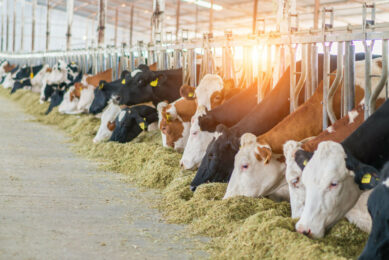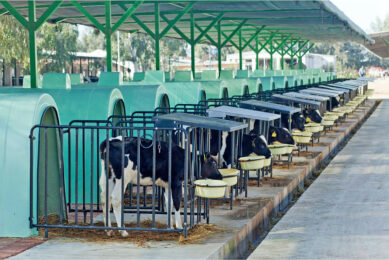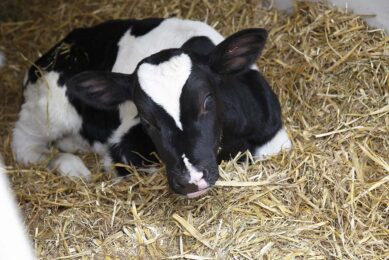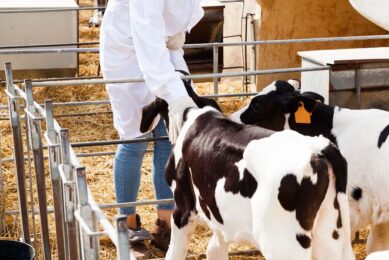Calf health: Know what’s vital and profitable
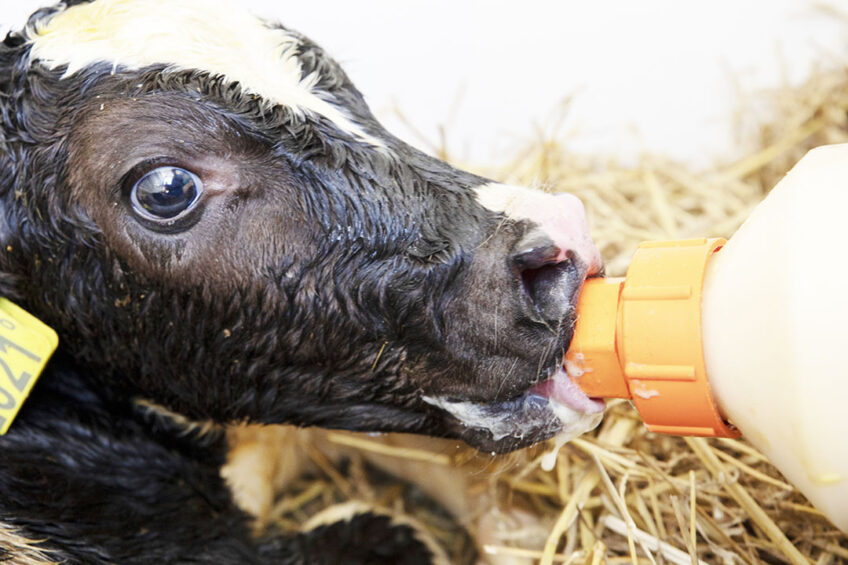
In a recent Agriculture and Horticulture Development Board (AHDB) webinar – Healthy calves, healthy profit – calves were the topic of the discussion.
Since smart calf rearing leads to healthy profits on-farm, it’s important to make sure that healthy calves remain a top priority.
Dr Robert Hyde from the University of Nottingham dived into the Calf Health research project conducted by Nottingham University, funded by AHDB. The project involves 60 dairy farms across the UK with the aim of looking at the various aspects that can impact calf health.

The first days of life are crucial for the calf. Building the immunity and growth rates should be a top priority for farmers. But how can farmers ensure that calves are on the right path, and which factors should be taken into account so that the calf will grow into a productive and well-performing animal? In his presentation, based on the research, Dr Hyde presented the areas farmers need to focus on when rearing healthy calves.
Calf housing management is a major point to consider, especially in the first weeks. This isn’t simply a question of which calf housing will work best on a particular farm. Dr Hyde said that “it’s much more important how calf housing is managed rather than the type of housing used,”, so clean and hygienic bedding and housing will have a positive impact in the short and the long term. Things like hygiene and ventilation are main factors to get right. 3 main areas which are key in building a strong, healthy and well-performing animal were brought to the fore in this webinar.
 Bee propolis improves calf health
Bee propolis improves calf health
Can bees offer more than just honey? Their craftwork ‘propolis’ has emerged to be a feed additive of value to the health of calves.
 Housing
Housing
- Temperature: Calves do not give off enough energy to heat up the calf house. Dr Hyde mentioned that “low temperatures means more calf death”. Therefore, farmers need to utilise methods that will help keep the calves warm throughout the year, not just during the winter months. A simple thermometer can be used for a simple indication of the day and night temperatures in the calf building. Ideally, it should be around 15°C for the first weeks of life. The lower critical temperature for calves under three weeks old is between 10–15°C.
- Bedding: Keep calves warm and make sure the bedding is clean and dry, this way the temperature will not drop and a lot of heat won’t be lost. A good rule of thumb of whether there is enough bedding is that the calf’s legs should not be visible when lying down. Deep bedding is not always possible and straw can be expensive. In terms of calf mortality, however, this is a good solution. Also, if it’s not a possible to create deep bedding for the entire pen, then providing one area that’s deeply bedded is a good option, said Dr Hyde.
- Proper ventilation is important in order to prevent respiratory issues like pneumonia. Think of creating microenvironments with straw bales etc. Farmers should ensure that there are no draughts. A good way to also keep an eye out for this is to watch the calves: if they are tucking themselves away somewhere or hiding behind a straw bale it may be an indication that they are too cold.
- Heating: heat lamps can be an effective way to keep the housing warm for calves, and it’s also a cost-effective way to ensure that the temperature is just right. However, Dr Hyde warns that these lamps are a fire hazard, so err on the side of caution. Jackets for calves are an excellent way to keep calves warm, but it’s important to keep jackets clean and dry between each calf, this way they are not a hindrance but an advantage in the progress of the calf performance. Check calves with jackets regularly to ensure comfort levels.
- Hygiene and cleaning are imperative. Calving pens should be cleaned out every 3 weeks and calf pens should be cleaned once per month.
 How to rear healthy youngstock
How to rear healthy youngstock
Healthy youngstock paves the way for a healthy herd later on. It is therefore imperative to ensure strong bones, muscles, legs and hooves.
 Colostrum – the 3 Q’s
Colostrum – the 3 Q’s
Colostrum is often referred to as ‘liquid gold’ because it provides many health benefits. New-born calves have no immunity against disease; therefore, colostrum management should be a major focus on any farm to fight disease and have less risk in succumbing to disease. Also important is the colostrum collection plan. Research suggests that farmers should look at their colostrum collection plan in terms of hygiene as equipment plays important role in the quality of the colostrum. Consider, for example, using scalding hot water to clean the dump bucket or colostrum feeding equipment instead of cold water, which can make high bacteria counts much more likely. What is being used to clean is also a point of concern, Dr Hyde said, “instead of using parlour wash or water, the use of Hypochlorite or Peracetic acid to clean collection and feeding equipment,” creates a low chance for a high bacterial contamination.
Dr Hyde further stated that “calves failing to get good immune transfer from colostrum are 1.5 times more likely to get scour, 1.8 times more likely to get pneumonia and twice as likely to die.” He further highlighted the 3 Q’s that serve as a good guideline in terms of colostrum feeding:
- Quickly – colostrum should be fed quickly and as soon as possible – so within 6 hours of the calf being born to allow the immunity to be transferred to the calf.
- Quantity – 3 to 4 litres to start within the first 6 hours of birth and then this should be built on as soon as possible, “in terms of energy requirements this is important to get to growth of 0.8 kg per day.”
- Quality – Colostrum can be tested for quality and calf blood can be taken by the veterinarian. Testing the colostrum encompasses the concentration of immunity and the cleanliness of the colostrum. Knowing what the bacteria levels are in colostrum is important as to avoid dangerous bacteria transfer to calves – the more bacteria, the less immunity the calf absorbs. Investing in a Brix Refractometer has its benefits and is cheap and reliable, as it provides knowledge on the immunity levels and also allows for testing of how much immunity has been transferred to the calf’s blood. This gives the farmer insights as to whether they should be feeding a different colostrum of a higher quality to the calf. Although not necessary in a colostrum management plan, pasteurisation of colostrum is a possibility if farmers are struggling to get bacteria levels low as it won’t affect the quality, or, as Dr Hyde said, “it’s hot enough to kill bacteria but it’s not hot enough to destroy immunoglobulins and proteins,”
 Call on dairy farmers for M.bovis study
Call on dairy farmers for M.bovis study
Scotland’s Rural College (SRUC) is curently urging dairy farmers to help with a project to find out the prevalence of Mycoplasma bovis (M.bovis) in Scottish dairy herds.
 Daily liveweight gain
Daily liveweight gain
This is an important factor when it comes to achieving a good growth rate in the pre-weaning animals. “For economic reasons and it can affect first lactation yield in dairy heifers,” Dr Hyde added. He stressed that there’s good evidence that a good growth rate can impact heifers and their performance in the first lactation. To improve growth rate, consider:
- Milk feed – at least 6-8 litres per day by about 2 to 3 weeks, depending on the calf factors like breeds etc. Dr Hyde said that it should be noted how important it is to get calves up to 8 litres per day as soon as possible and as soon as the calf is ready for it. Getting them up to a high level of feeding as quickly as possible is imperative for growth and energy to combat diseases.
- Calf buildings, temperature is important in growth rate – the warmer, the better the growth rate. Check that housing is draught-free as mentioned earlier and that bedding level is good and dry.
- Hygiene – calf pen clean out rate, calving pen clean out rate. Cleaning out more frequently leads to better growth rate and less chance of disease. Also, keep in mind that mixing older animals and younger animals isn’t recommended as it creates a big chance for pneumonia occurrence, which for example can have a longer-term impact when it comes to growth rates and performance, “they can have lung damage and scarring, sometimes for the rest of their lives, which really knocks their performance when they become heifers in that first lactation,” added Dr Hyde.
There is less disease risk when it comes to calves that are well taken care of, therefore they cost less to rear. Making the right decisions not only impacts profits in a positive way but also leads to happy, healthier and productive animals that will thrive throughout their lives.
Useful links mentioned during the webinar
- AHDB Better cattle housing design guide
- AHDB 3 Q’s of feeding colostrum guide
- AHDB colostrum hygiene video
- Nottingham herd health toolkit
The AHDB webinar took place on 9 September 2020, in conjunction with Farming Connect. More info can be found on AHDB.org.uk.



